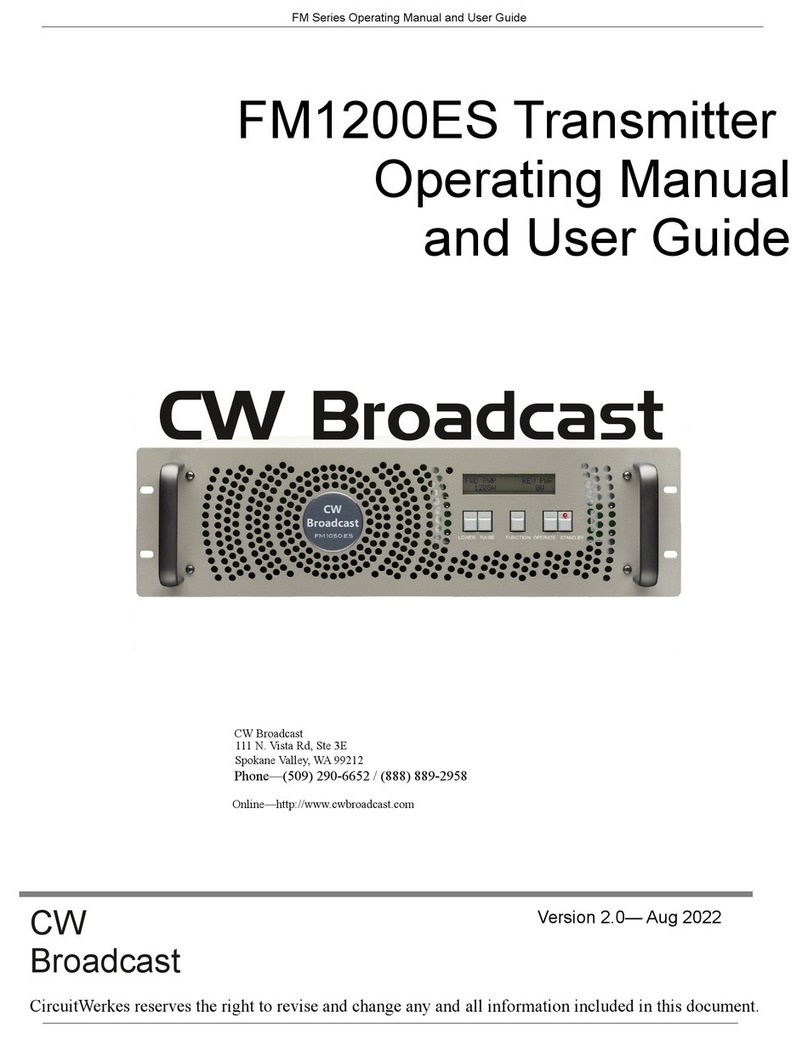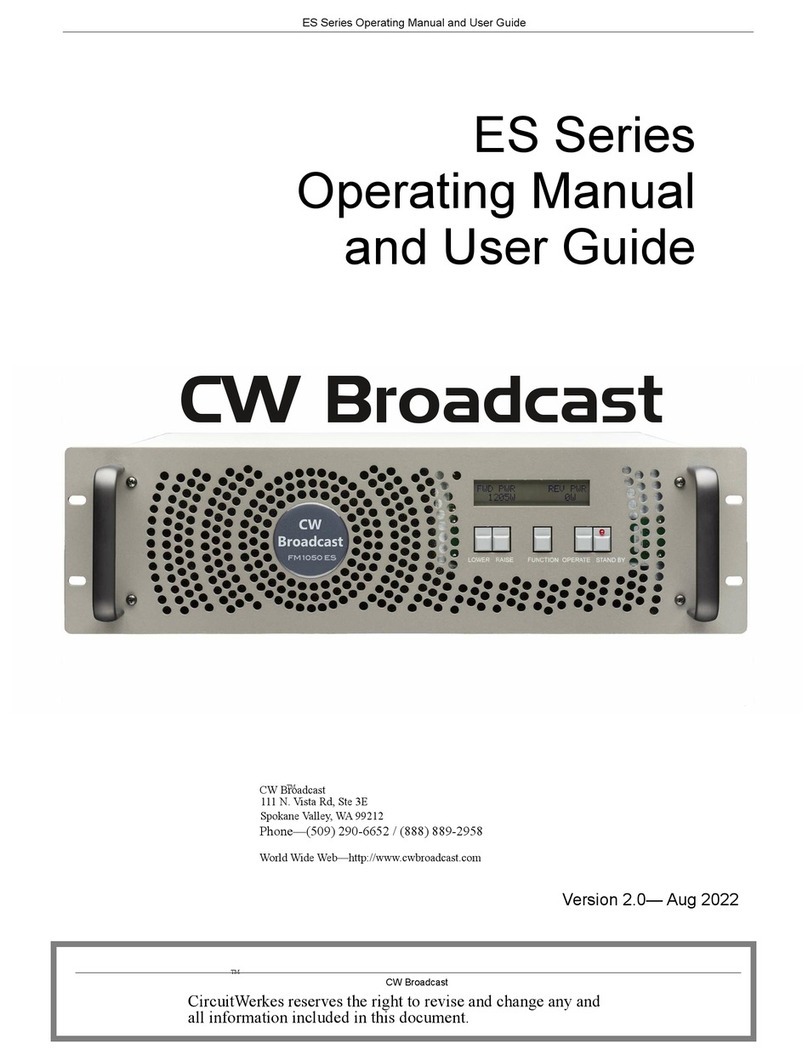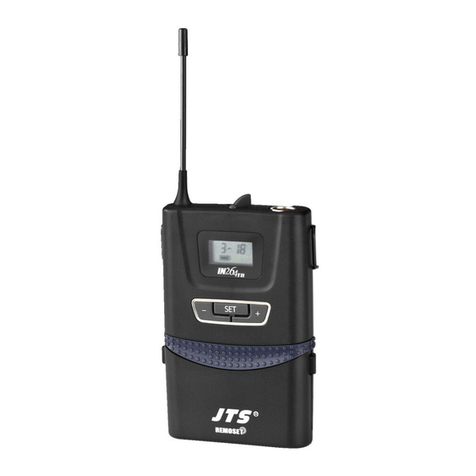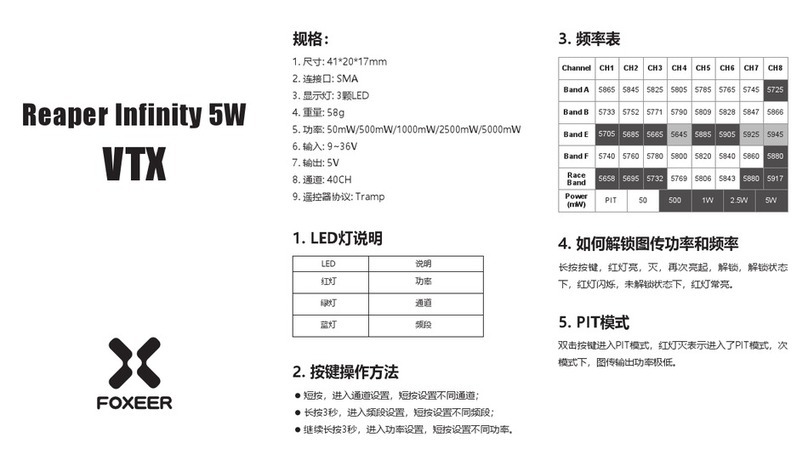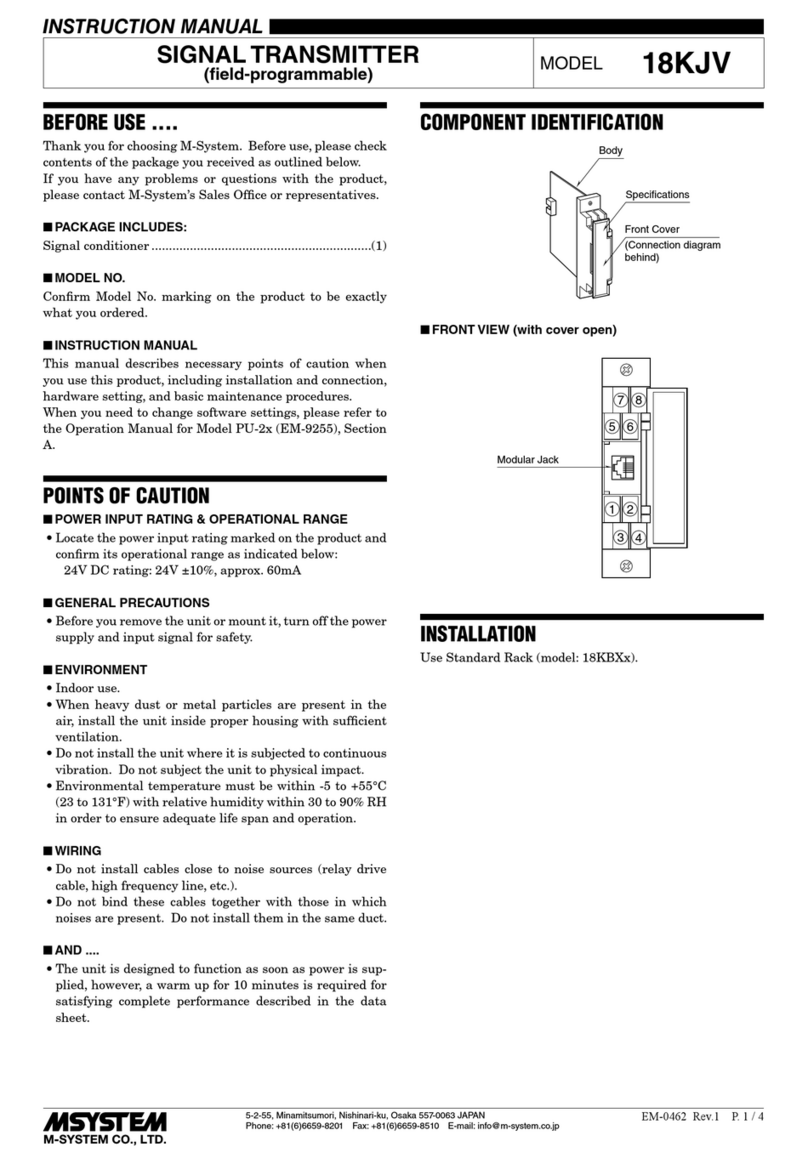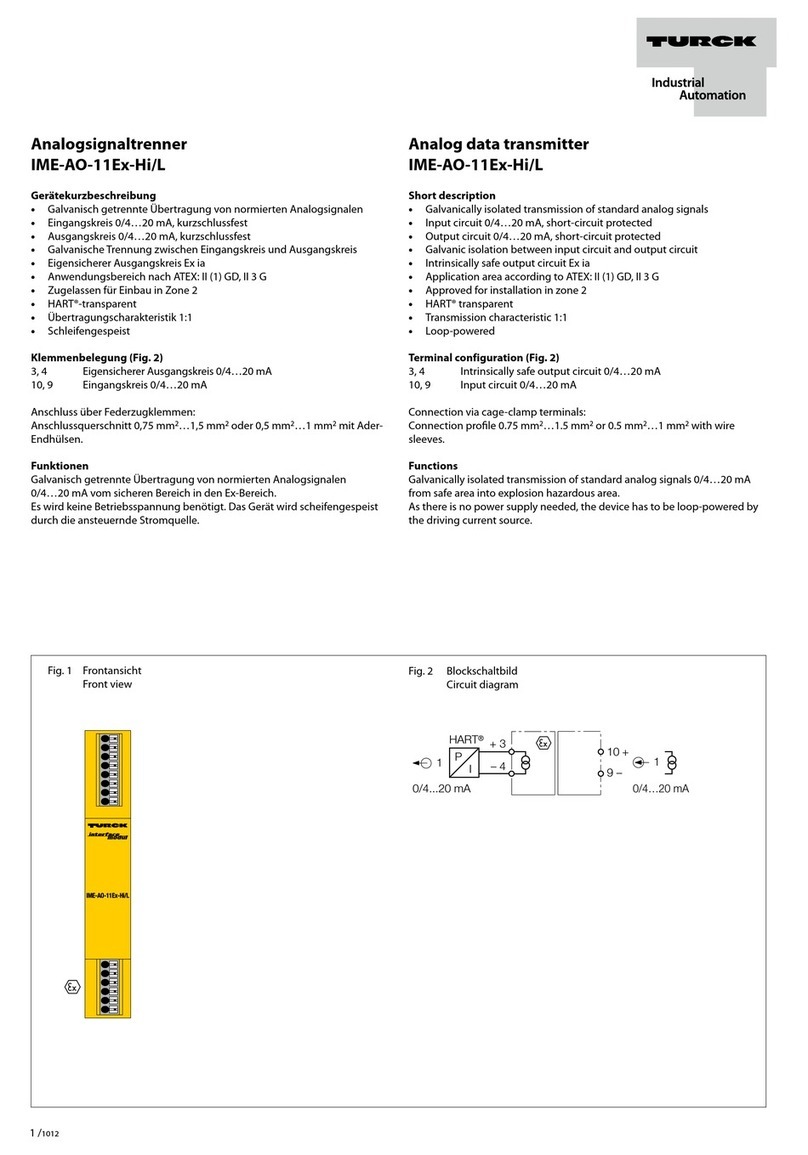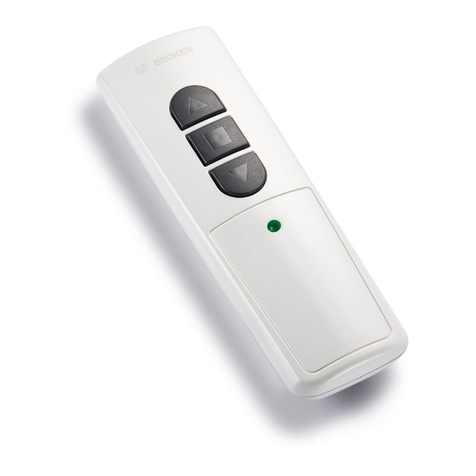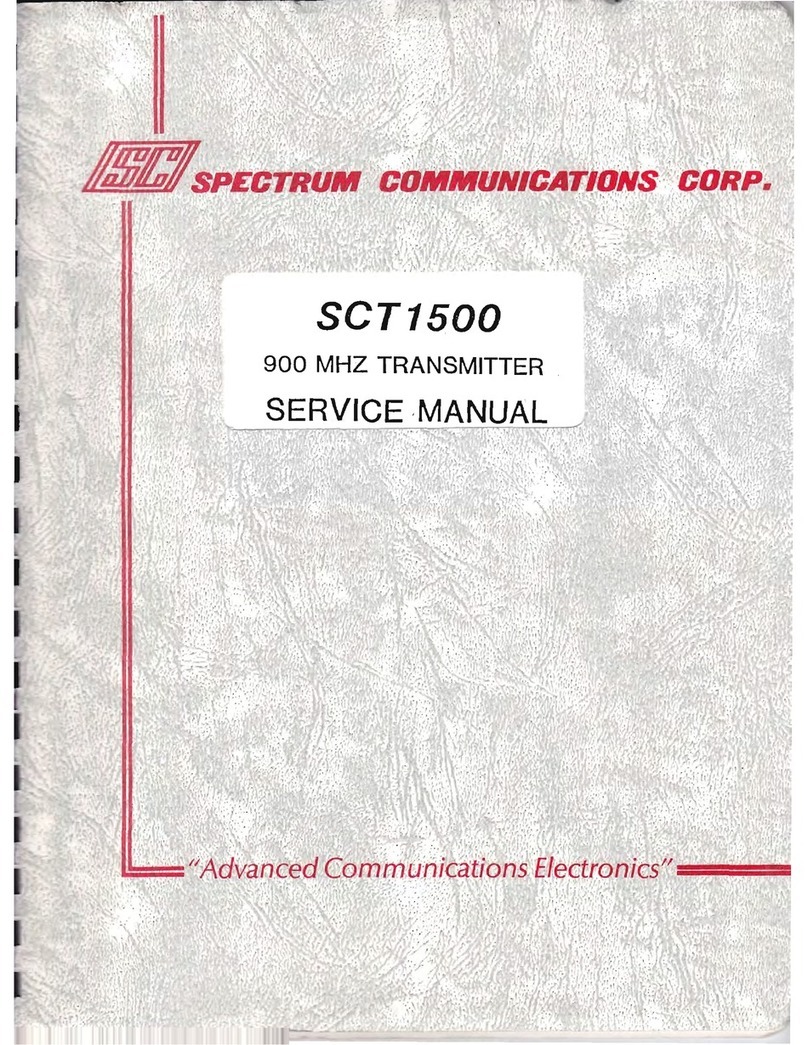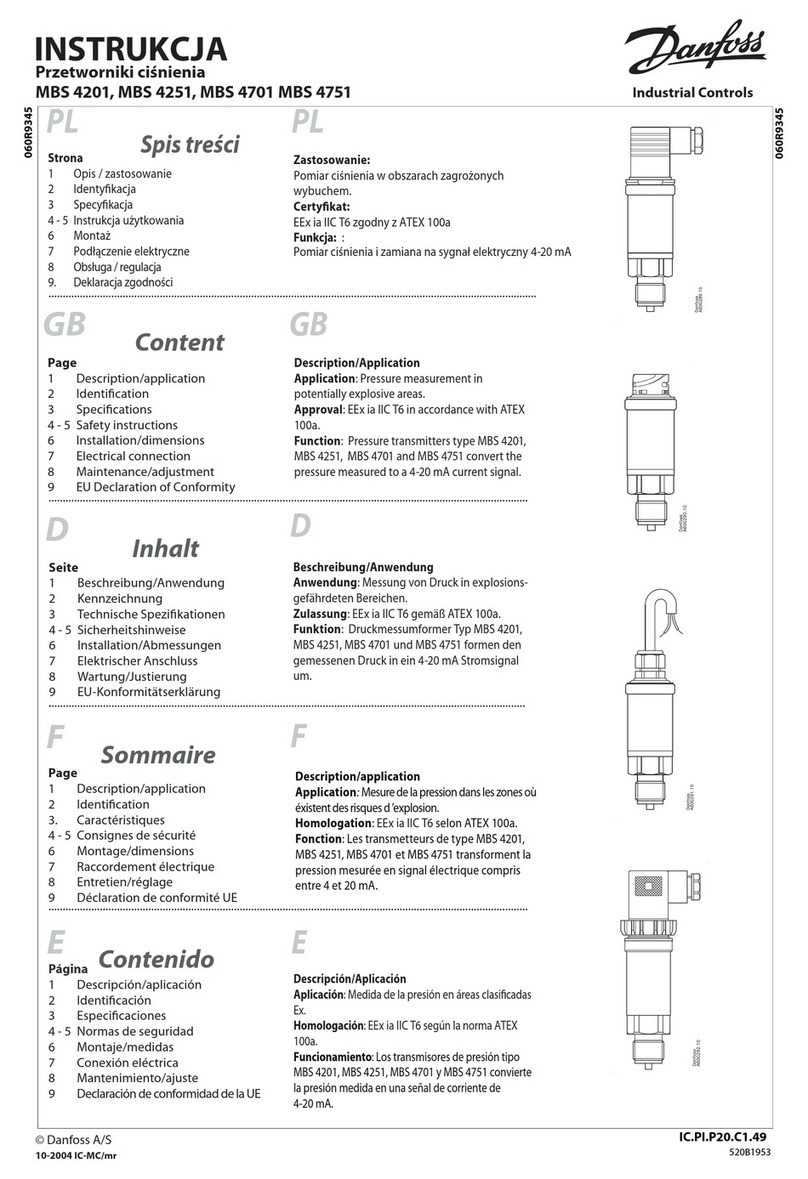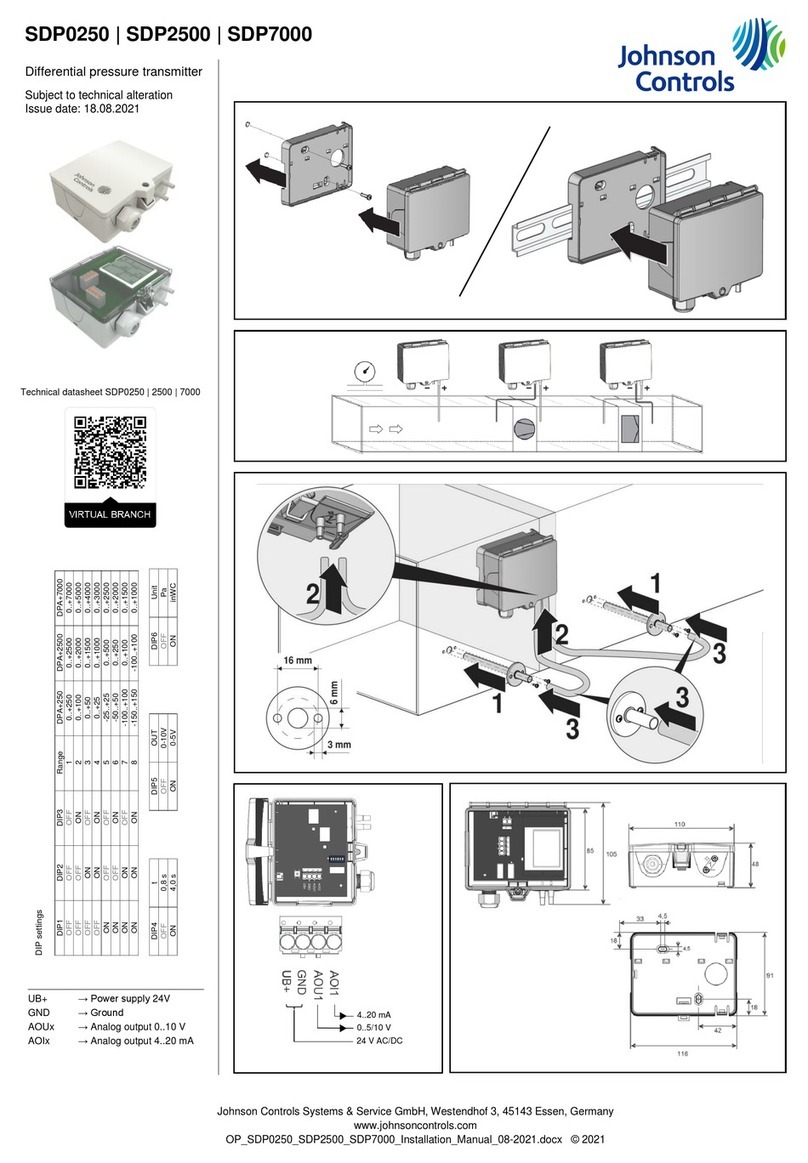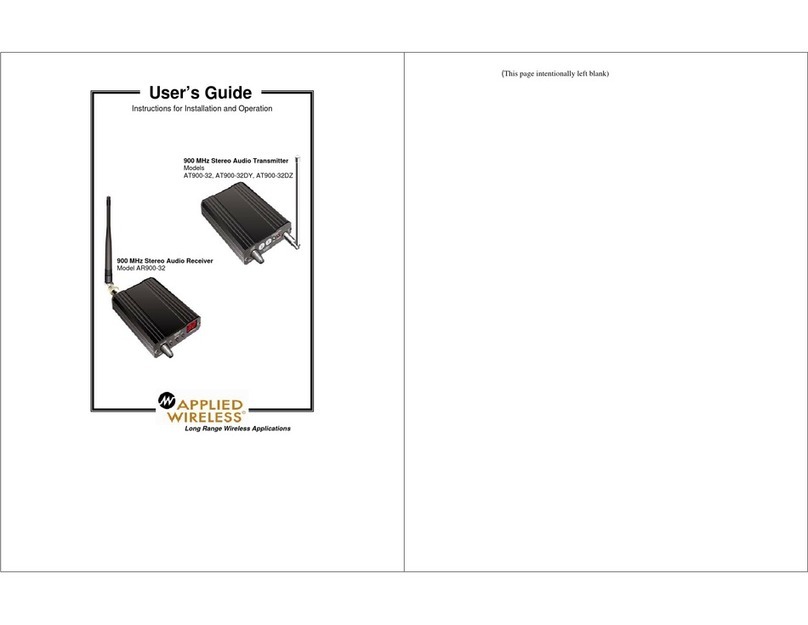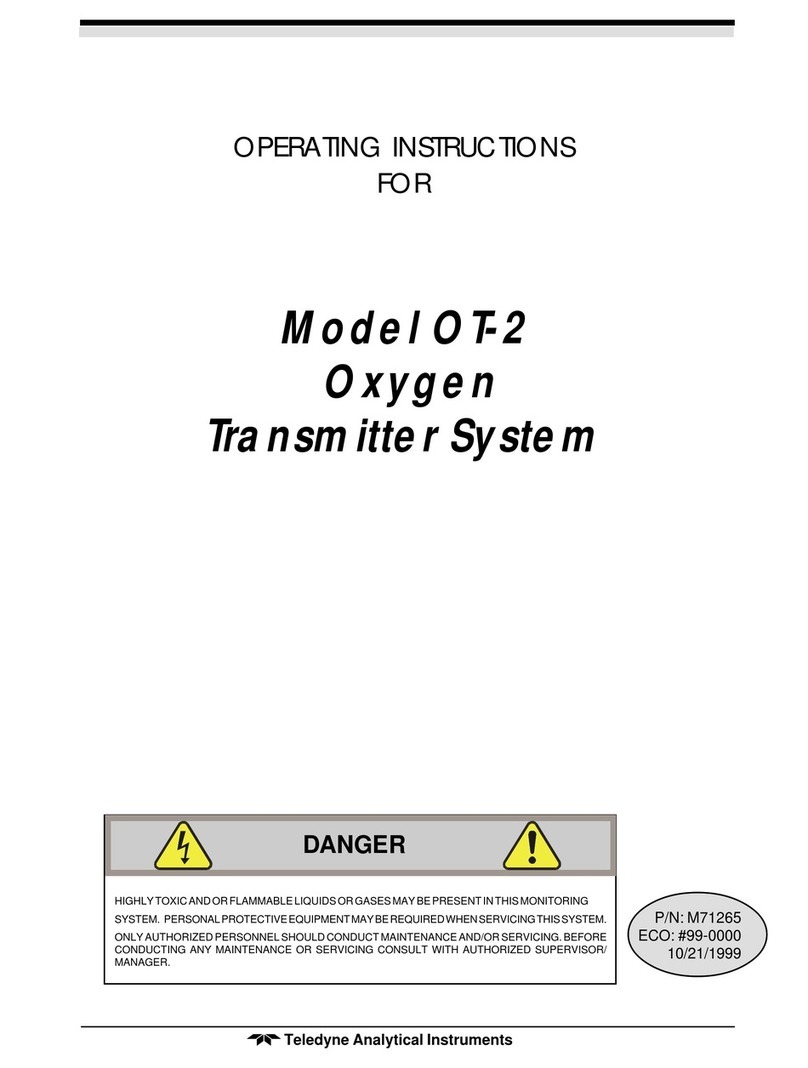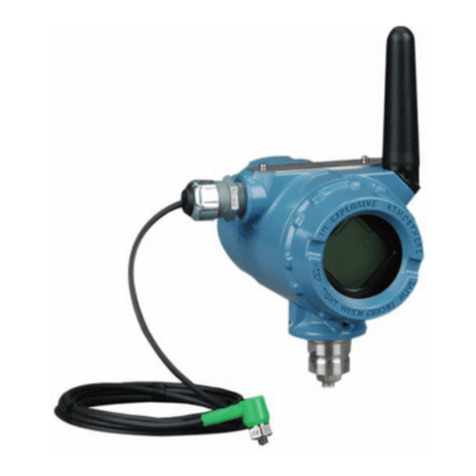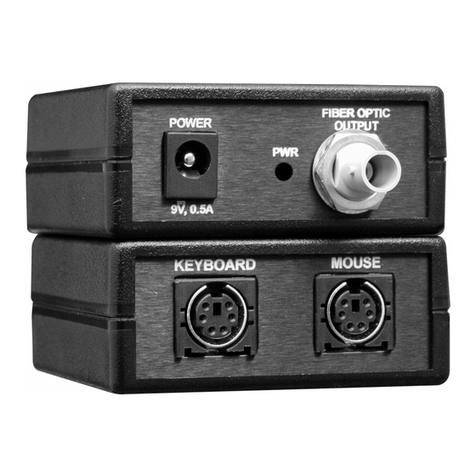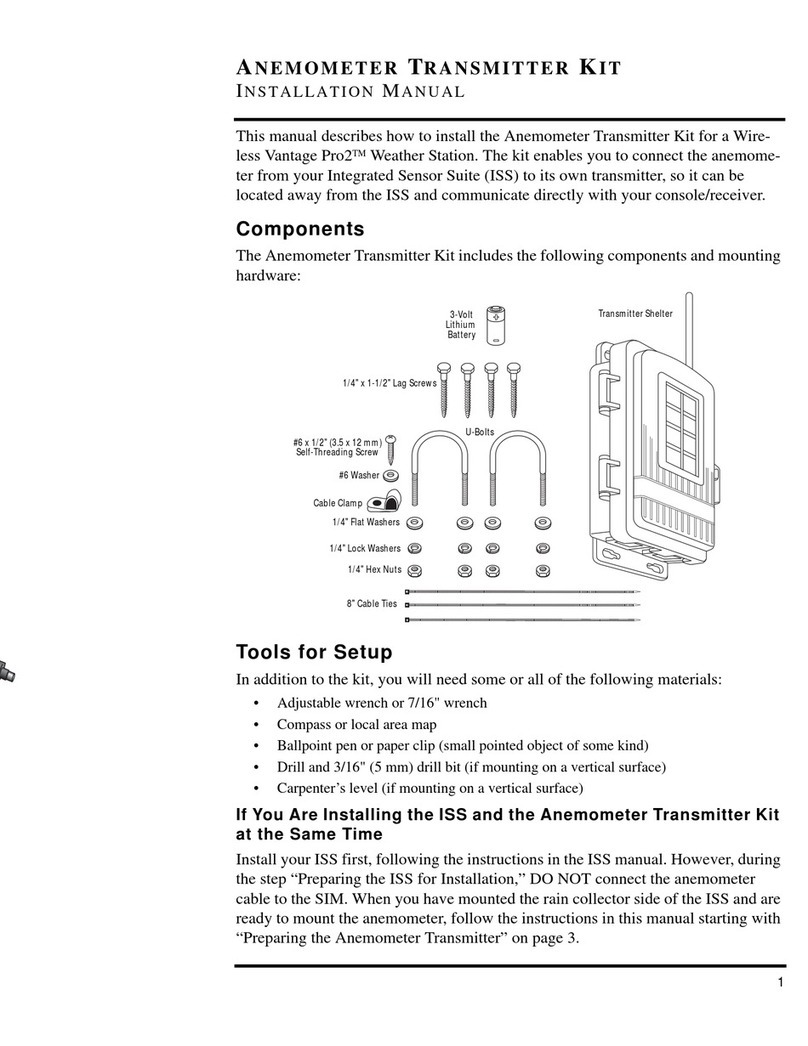CircuitWerkes CW Broadcast Gamma Guide

Gamma 2.0, 2.5, 3, & 3.5kW
Operating Manual
and User Guide
CW Broadcast
N Vista Way, Ste 3E
Spokane Valley, WA 992 2
(509) 290-6652

Copyright © 2023 CircuitWerkes, Inc. ALL RIGHTS RESERVED.
No part of this publication may be reproduced, transmitted, transcribed, stored in a retrieval
system, or translated into any language in any form by any means for any purpose other than
the purchaser’s personal use without the permission of CircuitWerkes, Inc..
The information in this publication has been checked and is believed to be accurate.
However, CircuitWerkes, Inc. assumes no responsibility for inaccuracies. CircuitWerkes, Inc.
retains the right to make changes to this publication at any time without prior notice.
CircuitWerkes, Inc. does not assume any liability arising from the application or use of this
publication or the product(s) described herein.
RESTRICTED RIGHTS LEGEND: Use, duplication, or disclosure by the United States
Government is subject to the restrictions set forth in DFARS 252.227-70 3 (c)(l)(ii) and FAR
52.227- 9.
This manual is for the:
2kW PS, 2.5kW PS, and 3kW PS
Operating Voltage Requirements:
***The CW Broadcast 2, 2.5, 3kW PS are Dual Phase 0VAC devices, more commonly
referred to as 220VAC***
Warranty Service
The Limited Warranty covers parts & labor to the original purchaser as outlined on purchase
invoice for use in the United States of America. To return a product for service, you must
contact customer service & get an RMA. Products returned without an RMA will be refused.
---These transmitters are not recommended for use as a replacement IP ---
Damage caused by misuse or shipping is excluded from the warranty. CircuitWerkes, Inc. will
not warranty the product due to misuse, accident, neglect, and improper installation or
operation. Proper installation includes A/C line surge suppression, lightning protection and
proper grounding of the entire transmitter, and any other recommendations designated in this
Operating Manual.
CW Broadcast
Customer Service Manager
N Vista Rd, Ste 3E
3

Spokane Valley, WA 992 2
(509) 290-6652 / (888) 889-2958
Safety Instructions
To maximize user safety and ensure correct device operation, all instructions contained in this
section should be read carefully.
Caution: It is important that the user observe all warnings and instructions that are
on the unit and contained in this manual.
Warning: DO NOT OPERATE IN AN EXPLOSIVE ATMOSPHERE
Operation of the PS Series in the presence of flammable gases or fumes can
endanger persons proximate to the site of operation.
Verify that the line voltage is 220VAC
Ground the Transmitter or mplifier
To minimize shock hazard, the exciter chassis must be connected to an electrical ground, the
exciter must be connected to the AC power mains through a three-conductor power cable,
with the third wire connected to an electrical ground (safety ground) at the power outlet. Any
interruption of the protective (grounding) conductor or disconnection of the protective earth
terminal will cause a potential shock hazard that could result in personal injury. If the exciter is
to be energized by any other source be certain that the chassis is connected to a separate
safety ground.
The inside of the product contains lethal voltages. LW YS disconnect the unit
from the AC power before opening any covers. When operating, the transmitter
can have high RF potential at various places, including, but not limited to, the RF
amplifiers, combiners Power sample boards, and low pass filters. Touching
these can result in serious RF burns or death. Never work on the transmitter
when energized and always ground every part before touching.
AC Line Fuses and Trips
4

The PS Series power amplifiers are provided with an 8 gauge 3 conductor “pig tail” AC Line
cord. This should be wired into a breaker box and feed with a 2 pole 35A breaker.
Output Connector
Warning: The Flange output connector carries dangerously high RF voltages that
present shock and burn hazards. Never operate the PS power amp without properly
terminating the output connector in either an adequately rated load or antenna.
Electrostatic Discharge (ESD)
A sudden discharge of electrostatic electricity can destroy static-sensitive devices or micro-
circuitry. Proper packaging and grounding techniques are necessary precautions to prevent
damage. Always take industry-standard precautions.
Grounding Methods
Guard against electrostatic damage at workstations by following these steps:
. Cover workstations with approved anti-static material. Provide a wrist strap connected
to a work surface and properly grounded tools and equipment.
2. Use anti-static mats, heel straps, or air ionizers to give added protection.
3. Handle electrostatic-sensitive components, boards, and assemblies by the case or the
PCB edge.
4. Avoid contact with pins, leads, or circuitry.
5. Turn off power and input signals before inserting and removing connectors or test
equipment.
6. Keep the work area free of non-conductive materials such as ordinary plastic assembly
aids and Styrofoam.
7. Use field service tools, such as cutters, screwdrivers, and vacuums that are
conductive.
General Safety Rules
5

•The device must be used in accordance with the instructions for use.
•Electrical installations in the room must correspond to the requirements of respective
regulations.
•Take care that there are no cables, particularly mains cables, in areas where persons
can trip over them.
•Do not use a mains connection in sockets shared by a number of other power
consumers. Do not use an extension cable.
•Only use the mains cable supplied.
•The unit is completely disconnected from the power source only when the power cord
is disconnected from the power source. Therefore, the power cord and its connectors
must always remain easily accessible.
•Do not set up the device in the proximity of heat sources or in a damp location. Make
sure the device has adequate ventilation.
•All plugs on the connection cables must be screwed or locked to the chassis housing.
•The device is designed to be used in horizontal position only.
•The device is no longer safe to operate when the device has visible damage or the
device no longer functions.
•In case of system malfunction or visible damage to the PS Series, the device must be
shut down and secured against unintentional operation.
•Repairs may only be carried out by authorized CW Broadcast personnel.
6

Preface
This document, entitled Gamma Operating Manual and User Guide , provides instructions on
how to install, configure, power up, and perform diagnostics on the 2.0, 2.5 and 3kW Gamma
FM Broadcast Transmitter. (see photo below). The information contained within is intended
for an experienced system operator with a knowledge of high-performance broadcast
transmission systems. The 4RU-high (7.0”) Gamma is designed to fit a standard 9” rack and
is provided with rack-mount left and right brackets and handles. Rack-mount slides are also
provided and must be used to mount the unit in a 9” rack cabinet
PS Series “Gamma” Transmitter / Amplifier
7

Key features of the PS Series CW Broadcast Transmitters include:
•Totally solid-state no-tune construction
•Wide input range from 2 0 to 264 VAC
•New comprehensive power and temperature monitoring system for improved reliability
•Remote-control interface (Webserver optional)
•Built-in stereo generator
•Meets or exceeds all FCC and CCIR standards
•24 month warranty (parts and labor)
•Designed, manufactured & supported in the United States
The Gamma series are FCC-type verified for use on FM stations. Frequency stability for each
unit is ensured by using DDS frequency synthesis from a highly stable crystal oscillator. All
units incorporate over-temperature protection and VSWR foldback to automatically reduce
power output to safe operating levels
Switch-mode power supplies provide consistent performance even when there are frequent
power outages and voltage fluctuations that make stressful demands on power dependence.
An overview and specifications of the Gamma series Broadcast Transmitters is given in
Chapter , "Overview and Specifications", of this manual.
CW Broadcast Online
Product information, including this manual, can be found on our Webpage at
www.cwbroadcast.com. You may also reach us by email at:
Your Feedback:
We are interested in improving our documentation and welcome your comments and
suggestions. You can email your comments to us at [email protected].
Please include the document part number in the subject line of your email.
8

Notes, Cautions, Warnings, and Sidebars
The following icons and formatted text are included in this document for the reasons
described:
Note: A note provides additional information concerning the procedure or action
being described.
Caution: A caution describes a procedure or action that may result in injury to the
operator or equipment. This may involve—but is not restricted to—heavy equipment
or sharp objects. To reduce the risk, follow the instructions accompanying this
symbol.
Warning: A warning describes a procedure or action that may cause injury to the
operator or equipment as a result of hazardous voltages. to reduce the risk of
electrical shock and danger, follow the instructions accompanying this symbol.
Sidebar: A sidebar adds detail to the section with in which it is placed, but is not
absolutely vital to the description of the procedure of that section.
9

Chapter
Overview and Specifications
. Overview
The Gamma series are FCC-type verified for use on FM stations. Frequency
stability for each unit is ensured by using PLL (phase-locked loop) frequency
synthesis from a highly stable crystal oscillator. All units incorporate over-
temperature protection and VSWR foldback to automatically reduce power
output to safe operating levels
Switch-mode power supplies provide consistent performance even when
there are frequent power outages and voltage fluctuations that make stressful
demands on power dependence.
The 4RU-high (7.0”) Gamma is designed to fit a standard 9” rack and is
provided with rack-mount left and right brackets and handles. Rack-mount
slides optionally available and are very helpful when mounting the unit in a 9”
rack cabinet.
10
A PS3000 Transmitter with rack slides attached.

11
Figure 1-1: PS Series Transmitter block diagram

The Gamma series is designed within a 4RU-high (3.5”) form-factor that is 24” deep (including
the front panel and rear protective flanges; the chassis body itself is 27” deep) and 7” (43.2
cm) wide ( 9” including the front panel to fit a standard sized rack).
Features on the Gamma front panel are shown in Figure -3.
12
Figure 1-2: PS Series Amplifier Block Diagram
LCD Display
Forward & Reverse Power
Deviation
PA Volts & Amps
Plug In Power Supplies
Standby (red illuminated in standby)
Operate
Function Select
Raise
Lower Handle
Handle
Figure 1-3: PS Series Front Panel

Fi ure 1-4 PS Series AMPLIFIER Rear Panel
Figure -5 PS Series TRANSMITTER Rear Panel
Composite
Input
13
RF Output (7/8” EIA Flan e or 7/16” DIN) Remote Control Connector
AC Input
SCA/RDS inputLeft & Ri ht balanced XLR inputs. Connect
– inputs to round for unbalanced use.
Ri ht = Mono In when stereo is OFF.

.2 Specifications
.2. General
Table - lists the general specifications for the PS series
Table 1-1: PS series General Specifications
14

.2.2 Electrical
Table -2 lists the electrical specifications for the PS Series.
Table -2 PS Series Electrical Specifications
.2.2. System Power
The PS Series is shipped with 2, 3 or 4 (dependent on model) “plug-in” AC power supplies
packaged separately to avoid damage. Each AC power supply has a 500-watt output
capacity that auto-ranges single-phase input from a 220 to 264 VAC (47 to 63 Hertz) source.
AC is supplied from a rear-mounted power connector
.3 Packing & Shipping
The PS Series transmitter is packaged in a reusable shipping container. Approximate weight
of an empty container and one ( ) AC power cord is 9 pounds (4 kg). The approximate weight
of a PS Series transmitter without power supplies is 70 pounds. The power supplies are
packed separately and weigh up to 25 pounds, depending on the number supplied.
15

Chapter 2
Installation
2. Installation Procedures
Caution: Use industry-standard ESD grounding techniques when handling all
components. Wear an antistatic wrist strap and use an ESD-protected mat. Store
ESD-sensitive components in antistatic bags before placing them on any surface.
Handle all IC cards by the front panel or edges only.
2.2 Rack Mounting
Warning: Make sure that the AC power cord is removed from the AC input
connector on the rear of the PS Series before installing
16
When installing the optional rack mounts (recommended), mount
slide to side of the Gamma use 0-32 Screws provided (5 places)
Figure 2-1: PS Series Rack Slides

17
Figure 2-2: Typical Rack Installation
ICXFR-3 49 9, 28U Rack

Figure 2-3: Fitting PS Series into Rack
Figure 2-4: Place the front panel screws
Using the supplied # 0 screws with nylon washers, screw the front panel securely to the rack.
18
Caution: This is a 2
person lift
# 0-32 screws (4 places)

2.3 Installing the Power Supplies
19
Figure 2-5. Inserting power supplies
. Place the power supply in the power supply slot.
Figure 2-6. Locking power supplies
2. With the handle in the up position press the power supply fully into the
slot.
3. Fully secure the power supply in place by pressing the handle down

2.4 Electrical Mains Connections
20
Table of contents
Other CircuitWerkes Transmitter manuals

